The Tangled Tree
Air Date: Week of September 28, 2018
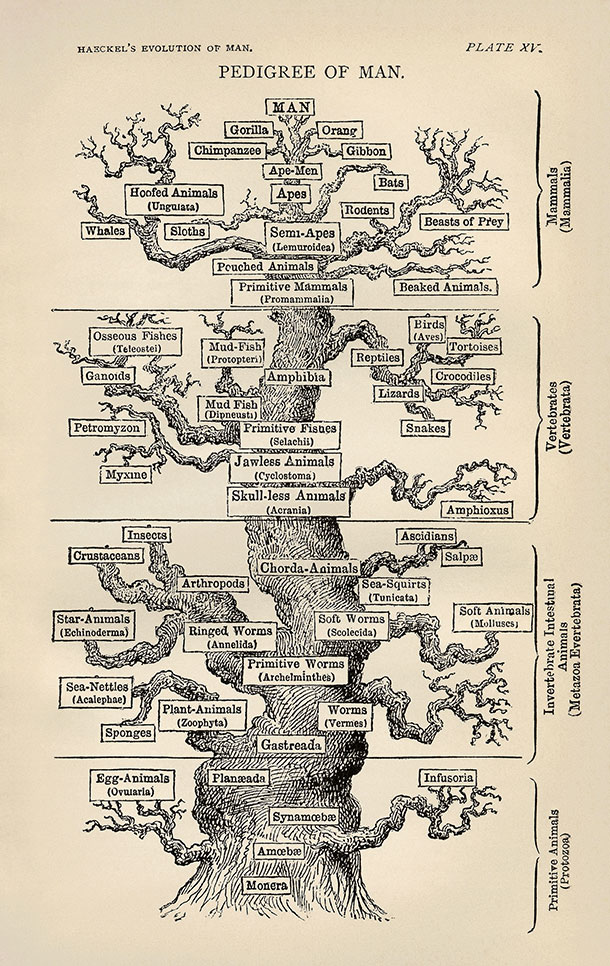
The “tree of life” as depicted by Ernst Haeckel, a German scientist who helped popularize Charles Darwin’s theories of evolution. In this English version of Haeckel’s tree from his book The Evolution of Man (1879), “man” sits at the top of the tree, the pinnacle of evolution. (Photo: Ernst Haeckel, American Philosophical Society Museum, Wikimedia commons, public domain).
The tree of life proposed by Charles Darwin in the 19th century, depicts different forms of life diverging from one another as they evolve down through successive generations. But discoveries of new life forms and the phenomenon of horizontal gene transfer indicate life can also evolve through convergence. Author David Quammen discusses these discoveries in his new book, The Tangled Tree: A Radical New History of Life. He spoke with host Steve Curwood.
Transcript
CURWOOD: It’s Living on Earth. I’m Steve Curwood.
About a hundred and sixty years ago Charles Darwin wrote Origin of the Species, postulating that life on earth evolved from ancient species that diverged over time, rather like a tree branches from a single trunk. Scientists focused how diverging species inherited characteristics, as genes were passed and sometimes mutated from one generation to the next.
Well, we know life can be complicated, so we should not be surprised that evolution is not just based on the tree of life and inherited genetics. We learned in 1970’s that there are creatures that are kind of between single celled bacteria and multi cellular creatures like humans, a category of life called archaea that could hold the key to how life got started on earth. And now science has discovered horizontal gene transfer, which is changes genomes via sideways infection, sometimes across species.
Author David Quammen tells the story of this new understanding of evolution in his book, The Tangled Tree: A Radical New History of Life. David joins us from Bozeman, Montana. Welcome to LOE!
QUAMMEN: Thank you, Steve. Very good to be with you.
CURWOOD: So, what is the story that you set out to tell?
QUAMMEN: Well, it's the story of the tree of life as the image of evolutionary history on Earth, which goes back to Darwin and the way that image, that tree, has been radically challenged and radically revised in the last 40 years because of discoveries from genome sequencing, a kind of evidence that Darwin and most biologists in the 20th century didn't have, and those challenges have been astonishing, counterintuitive, and re-shaped what we thought we knew about the history of life on Earth.
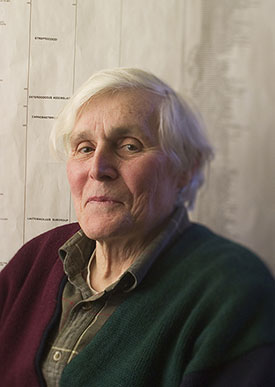
A portrait of Carl Woese shows the microbiologist in his later years, photographed at the University of Illinois where he was faculty member of the Institute for Genomic Biology and where he made his discovery of the third kingdom of life, the Archaea. (Photo: Don Hamerman, Wikimedia commons, CC BY 3.0)
CURWOOD: To summarize, I think it's fair to say a big takeaway here is that what we think of as species, what we think of as individuals, and for that matter, the whole tree of life where evolution shows species neatly divergent from its origins, well, is not exactly right. Why is that?
QUAMMEN: That's putting it politely. I say at the end of the book after having told the stories of these people and their discoveries, that this whole revolution has challenged three categorical ideas, and that's the idea of species, the idea of individual and the idea of the tree of life. The idea of a species, that it's a unitary thing, it's a population of creatures that are similar to one another, and they interbreed with one another and only with one another. The idea of an individual, there is an individual named Rufus the brown dog, there is an individual named Charles Robert Darwin, there's an individual Steve Curwood, David Quammen, and we are unitary and discreet, and thirdly the tree of life represents the history of life on Earth. It is a tree shaped history, and it turns out that all three of those ideas, those categories, are wrong in important ways.
CURWOOD: Now, let's talk for a moment. Yours is a story of people, scientists trying to understand life and how it has evolved, how it continues to evolve. Tell me about some of the characters in your story, especially Carl Woese.
QUAMMEN: Yes, so I came across this fellow early on in my own discovery of the subject. Carl Woese, a microbiologist at the University of Illinois, who came out of nowhere and suddenly in November 3, 1977, appeared on the front page of The New York Times, above the fold, a picture of him and a story about his discovery of a third kingdom of life on Earth, a separate form of life that was unknown to exist before that. Before that we thought there were basically two kinds of life bacteria and everything else. Bacteria were simple cells. Everything else was composed of complex cells with cell nuclei, animals, plants, fungi, humans. And Woese came along and said, now wait a minute, I've discovered a third form, and that was the beginning of a sequence of discoveries that he essentially triggered that have led to this new understanding.
CURWOOD: And by the way, what was it that he discovered what was between bacteria and multicellular organisms?
QUAMMEN: There was a group of organisms now known as the archaea, archaea as in archaeology suggesting old, because it was thought that they were the oldest form of life on Earth maybe. These were creatures that had been taken for bacteria for decades and decades. Ever since people started looking at microbes through microscopes, they thought that these things were bacteria. Woese started sequencing their genomes, and lo and behold, he said no, these things are not bacteria. If you look at their genomes, they're not only distinct from bacteria, but they're more similar to us, to humans, to all animals, to plants than they are to bacteria. They are radically distinct, and so he announced in a scientific paper and the press announced in headlines that he had discovered a separate form of life, the third major kingdom.
CURWOOD: Now, by the way, about this kingdom that Carl Woese discovered, this are pretty tough characters aren't they? They're in hotspots, very extreme temperatures, that sort of thing.
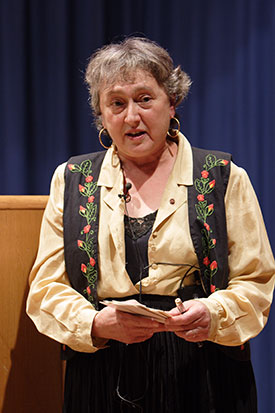
Lynn Margulis, an American microbiologist, revived the theory of what she called “endosymbiosis” which asserted that mitochondria were descended from captured bacteria. When Carl Woese’s methods came along, her theory was proven correct. (Photo: Javier Pedreira, Wikimedia commons, CC BY 2.0)
QUAMMEN: Well, these creatures, the archaea, at first they seem to live entirely in extreme environments, as you said, hot springs in Yellowstone Park, thermal vents at the bottom of the ocean, highly acidic environments. More and more as scientists discovered ways to sequence DNA just out of the wild, they have discovered these creatures live in a lot of different environments, not all of which are extreme. But one of the groups of extremity loving archaeans live near vents at the bottom of the Atlantic Ocean almost 10,000 feet down between Norway and Iceland, and those archaea are called Lokiarchaea and it's now thought that they, in fact, are the descendants of our original ancestors, that we, all complex creatures, grew out of an ancestor that more closely resembled one of these archeans living in a vent at the bottom of the Atlantic Ocean, than having come from anywhere else. That those are, how to put it, they're the descendants of our ultimate ancestors that we come from archaea and not from say the bacterial side of the tree of life.
CURWOOD: Then raises the question maybe they came from someplace else because if they're really tough noogies, they might have survived interstellar space.
QUAMMEN: That's why NASA funded Carl Woese's work. His original funder, when he discovered the archaea, one of his funders was the National Aeronautics and Space Administration. Why? Because they thought that his work might shed light on the problem of exobiology, the possibility of the existence of life on other planets, other star systems, other places around the universe.
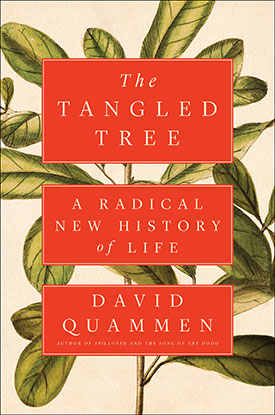
The cover of David Quammen’s new book, The Tangled Tree. (Photo: Courtesy of Simon and Schuster)
CURWOOD: Tell me a bit more about Carl Woese, the man.
QUAMMEN: He was a biophysicist. He was trained at Amherst and then at Yale in biophysics, that was his Ph D, and then he went to work for the General Electric labs in Schenectady, New York. They hired him as a research molecular biologist, and he really had no idea what they wanted him to be doing. He sat in a lab in Schenectady for a few years noodling around and trying to make some important discoveries. He was always interested in pure science and the deep questions: What is the shape of the early history of life and the history of life since then. Eventually he was hired away to the University of Illinois where he could be a cranky crotchety professor that didn't spend much time with undergraduates. He was a terrible lecturer. He was reclusive. He didn't participate in faculty committees. He was just this brilliant grouch who could be wonderful to his students, could be a fine generous mentor, but could also be this total reclusive grump, a complicated man with different sides to him, which is part of what attracted me to him as a character, as the central character of the book. The other thing that attracted me was that I quickly saw that he's probably the most important biologist of the 20th century that nobody has ever heard of.
CURWOOD: So, one could say that convergence is a major theme of your book, and of course, in the Darwinian tradition where genes passed vertically from parent to offspring, we draw trees to represent these movements and it's the limbs on the tree only diverge from other branches. But, David, if the tree of life is not actually a tree, how might we best describe evolution based on what you've researched and written about here?
QUAMMEN: Well, some people say we should think of a web and not a tree of life because as you say convergence is very very important. A network of life. One fella suggested a circle of life, and yet the tree is still mostly right. It captures some big patterns, but there are exceptions to those patterns. The tree image was valuable to Darwin and the people who followed him because it represented the divergence that has occurred through the history of life. One lineage diverging into two lineages, one limb into two branches etcetera, and species diverging from one another. All of this divergence that lead to the diversity of life that we see on Earth now. But it's not just a matter of divergence. The discoveries that flowed from from Woese's work and his methodology, including things like the prevalence of a phenomenon called horizontal gene transfer - genes moving sideways across boundaries - those represented convergence. And so, the real history of life is a history of lots and lots of divergence complicated by a lesser but very significant amount of convergence - genes moving sideways, branches of life coming back together - and that's why I titled my book "The Tangled Tree".
CURWOOD: So, let's talk about horizontal gene transfer please describe this phenomenon for us and and how revolutionary a discovery it was.
QUAMMEN: Right. Well, when I first came across this probably back in 2013. I had written three, maybe four books about evolution before that and I had never heard of horizontal gene transfer. So, suddenly I came across it reading some scientific article or a blog or something in 2013, and my first reaction was, what, that's impossible, that's just not supposed to happen. I mean, yes, if you have two very similar species closely related, then sometimes individuals mate and hybrids are born and occasionally those hybrids are even fertile. So, the two closely related species may overlap and connect a bit, but that's not what we're talking about. We're talking about genes moving across broader gaps from one unrelated species of life into another. Horizontally, as opposed to vertically, which represents parents to offspring, ancestors to progeny. This was sideways movement of genes, so that a gene from a bacterium is showing up in an animal, a gene from a virus is showing up in an animal, a gene from one kind of animal is showing up in a completely different kind of animal. How can that happen? The short answer is infection. One scientist called this infective heredity.
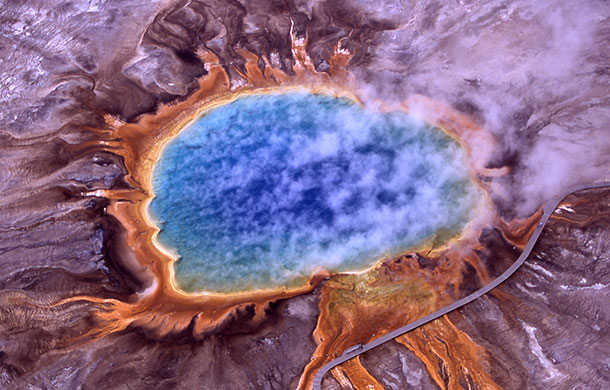
Many species of archaea thrive in extreme environments, such as hot springs like Grand Prismatic Spring in Yellowstone National Park. (Photo: Jim Peaco, National Park Service, Wikimedia commons, public domain)
CURWOOD: How accurate is it to say that bacteria can become part of our cells in the form of mitochondria?
QUAMMEN: Well, mitochondria are an important part of the story. Mitochondria are these little organs, they call them organelles in cell biology. They're the organs in ourselves that package energy. We have thousands of them in each of our cells, and they're completely essential for packaging energy that our complex cells can use. So, where do those mitochondria come from?
Well, it turns out they are descended from captured bacteria. They have DNA in them, but it's essentially not human DNA, it's bacterial DNA. What happened? Well, about two billion years ago, one ancestor cell of all complex creatures either swallowed or was infected by a single bacterial particle, and instead of digesting it or rejecting it, it accepted it and that bacterial particle stayed replicated, adapted, changed, became symbiotic with the host cell that it was in and eventually evolved into mitochondria. This was an idea proposed back in 1967 by the great microbiologist Lynn Margolis and everybody thought she was crazy, and most people thought she was crazy. And then when Carl Woese's methodology came along, she was proved right.
CURWOOD: Now when Lynne Margolis came up with what was her concept? She called it something like genetic chimera.
QUAMMEN: Yes, she called all creatures chimera, meaning composites of different kinds. The Greek chimera is a combination of say a lion and a hawk. She revived this theory that she called endosymbiosis, and part of the theory was this idea that our mitochondria are captured bacteria, and she also argued that there are organelles in plants cells called chloroplasts that do the photosynthesis. She argued those too were captured bacteria. And then people came along in the footsteps of Carl Woese and said, well, let's test that idea by sequencing the DNA in mitochondria, these organelles in chloroplast, and when they sequenced the DNA those organs contained DNA themselves, apart from the DNA in the nucleus of our cells. People sequence that DNA and they said, son of a gun, this is a bacterial genome inside the mitochondria. These things are captured bacteria, the descendants of anciently captured bacteria.
CURWOOD: So, these days then there is though a fair amount of horizontal gene transfer happening, but it's mostly what among the bacteria themselves?
QUAMMEN: Yes, it seems to be very common among bacteria, almost routine among bacteria. They are, as I said, simple cells. They don't have their genomes locked up inside cell nuclei. Their genome is a single strand of DNA, and it floats free in the cell, and occasionally one bacterium sends out a little tube almost like a penis to another bacterium, and DNA travels through that tube into the other bacterial particle. But it doesn't have to be the same species of bacteria, which is what makes this horizontal gene transfer so scrambling, so consequential.
CURWOOD: And how is this related to antibiotic resistance?
QUAMMEN: This is essential to understanding the spread of antibiotic resistance around the planet as a global public health problem. This kind of transfer that I just described, with the tube that goes out, and a little loop of DNA being sent through that tube from one kind of bacterium into another, this, scientists now understand is what accounts for the speedy spread of antibiotic resistance around the planet. What do I mean by that? Well, resistance to one kind of antibiotic can evolve gradually in one kind of bacterium by the old fashioned mutation incremental mutations, the old fashioned Darwinian mechanism, and the natural selection works on that, and then after a period of time, well, this bacteria A is resistant to antibiotics, one, but now we know that by horizontal gene transfer once that's happened bacteria A can pass that resistance gene to bacterial B C D F G in an instant by horizontal gene transfer, and can receive other resistant genes the same way. In fact, there are now whole packets of genes for resistance to four or five different kinds of antibiotic that can be passed in an instant from one kind of bacteria into a completely different kind. So, the problem rises by Darwinian mutation and natural selection, and it spreads lightning fast around the planet by horizontal gene transfer.
CURWOOD: Oh my, so David, I want to go to this question of just who are we, who or what is David Quammen, who or what is Steve Curwood. What is an individual if we're not the sort of individuals we thought we were looking at Darwin's thinking of evolution?
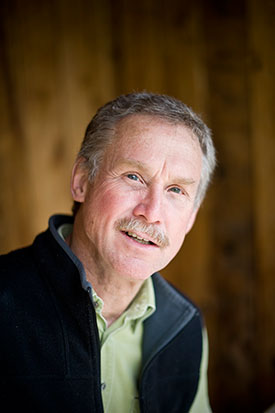
David Quammen is an award-winning science writer and journalist. (Photo: Lynn Donaldson)
QUAMMEN: Well, Lynn Margolis would say we are chimera. Others would say we're mosaics. We are individuals, as we've said before, but our individualness, our individuality is a compoundment of other creatures and DNA that has come to us by several different routes. One route is through lineal descent through all of our line of animal ancestors, but DNA has also come into us by horizontal gene transfer, come into us sideways, come into us by infection, so that, Steve, you and I and every other human now, our genomes are eight percent viral, for instance, eight percent of our genome is viral DNA that has come in sideways by infection, plus, we contain bacterial DNA in the form of all the mitochondria and ourselves, plus we probably contain other bits of bacterial DNA that has been brought into our genomes by infected heredity, by horizontal gene transfer. So, who are we? Well, we are individuals in quotation marks who represent the phenomenon of mixing as well as the phenomenon of linear evolution that have shaped life on this planet. I think that that's a humbling thought, but it's also an inspiring thought. It connects us even more closely with all other kinds of life and with the history of life on this planet.
CURWOOD: David Quammen is an award winning science writer and journalist. His book is called "The Tangled Tree", a radical new history of life. David, thanks so much for taking the time today.
QUAMMEN: Steve, thank you. I've enjoyed it.
Links
Living on Earth wants to hear from you!
Living on Earth
62 Calef Highway, Suite 212
Lee, NH 03861
Telephone: 617-287-4121
E-mail: comments@loe.org
Newsletter [Click here]
Donate to Living on Earth!
Living on Earth is an independent media program and relies entirely on contributions from listeners and institutions supporting public service. Please donate now to preserve an independent environmental voice.
NewsletterLiving on Earth offers a weekly delivery of the show's rundown to your mailbox. Sign up for our newsletter today!
 Sailors For The Sea: Be the change you want to sea.
Sailors For The Sea: Be the change you want to sea.
 The Grantham Foundation for the Protection of the Environment: Committed to protecting and improving the health of the global environment.
The Grantham Foundation for the Protection of the Environment: Committed to protecting and improving the health of the global environment.
 Contribute to Living on Earth and receive, as our gift to you, an archival print of one of Mark Seth Lender's extraordinary wildlife photographs. Follow the link to see Mark's current collection of photographs.
Contribute to Living on Earth and receive, as our gift to you, an archival print of one of Mark Seth Lender's extraordinary wildlife photographs. Follow the link to see Mark's current collection of photographs.
 Buy a signed copy of Mark Seth Lender's book Smeagull the Seagull & support Living on Earth
Buy a signed copy of Mark Seth Lender's book Smeagull the Seagull & support Living on Earth

